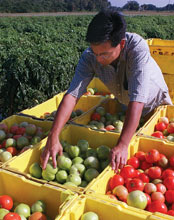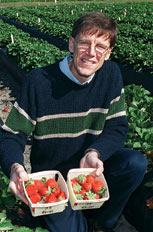article
by Joe Kays downloadable
.pdf
Florida
has always been an enigma to farmers. The state’s warm
climate provides unique “market windows” when
farmers can harvest crops like blueberries and tomatoes that
are unavailable anywhere else. But that same climate lacks
adequate “chilling days” needed to set fruit and
the heat and humidity spawns a multitude of insects and diseases.
Since
1888, scientists with the Florida Agricultural Experiment
Station, or FAES, have sought to exploit the advantages of
Florida’s climate and thwart its disadvantages. The
dozens of new and improved fruits, vegetables and other crops
made available to farmers through FAES have resulted in a
$50 billion agriculture business in Florida.
|
| Richard
Jones, dean for research and director of the Florida Agricultural
Experiment Station, displays some of the hundreds of varieties
of fruits, vegetables and other agricultural products
developed by FAES. |
As
the research arm of the University of Florida’s Institute
of Food and Agricultural Sciences, FAES working in concert
with federal and other state governments on research related
to food and agriculture, natural resources, environmental
quality, human nutrition, rural development and related areas.
“New
plants developed at the Florida Agricultural Experiment Station
have been vital to the state’s agricultural industries
and to consumers here and throughout the country and the world,”
says Richard Jones, director of the FAES. “Almost every
crop variety grown in Florida came from plant breeding programs
at FAES.”
The
FAES statewide research program is administered through 20
academic departments in Gainesville, 13 Agricultural Research
and Education Centers throughout the state, eight multidisciplinary
centers, the School of Forest Resources and Conservation,
and the College of Veterinary Medicine.
Since
its inception, FAES has concentrated on breeding varieties
that are adapted to Florida’s unique environment. Until
recently, all of this research was done through traditional
plant breeding programs, cross-breeding the best examples
of plants with unique characteristics, like heat or disease
tolerance, through many generations to achieve superior varieties.
Today, molecular genetics also is used to speed up the process
of developing a new variety and to enable the introduction
of novel traits.

Anyone who has ever tried to grow tomatoes knows that all
kinds of things can go wrong with this tasty, but finicky,
fruit.
Since
the release in 1925 of a variety called Marglobe, FAES has
been instrumental in developing tomato varieties that are
adapted to Florida’s climate, taste good and are resistant
to disease. Today, more than 50,000 acres of tomatoes are
grown in Florida from October through June, with a value of
more than $500 million annually.
 |
| Tomato
breeders at UF’s Gulf Coast Research and Education
Center in Bradenton evaluate tomatoes for their taste,
hardiness, yield and other traits in the course of developing
new varieties.
|
A
milestone in tomato breeding in the 1950s was Manalucie, a
variety developed by FAES breeder J.M. Walter that had improved
fruit quality and was resistant to multiple diseases. In 1969,
FAES released the world’s first tomato variety with
resistance to Fusarium wilt, a race 2 disease that was causing
major losses to the Florida tomato industry. And a cooperative
project in the 1960s between FAES and the H.J. Heinz Company
led to varieties with firmer fruit that could more easily
be shipped and even machine harvested.
Since
the 1980s, genetic markers have been instrumental in advancing
the selection process for tomato varieties. Markers linked
to resistance genes for Fusarium wilt, spotted wilt and geminiviruses
were discovered by FAES scientists and are now incorporated
into commercial hybrid varieties in Florida. In collaboration
with U.S. Department of Agriculture (USDA) and industry, FAES
scientists also have initiated a program to identify genes
controlling tomato flavor. Molecular markers that track various
chemicals contributing to flavor are being isolated.

1948 was a good year for berries in Florida. That year, FAES
horticulturist Ralph Sharpe noted that the market for fresh
blueberries in the United States was expanding rapidly but
that no blueberries were available until late May, when harvest
began in eastern North Carolina.
Sharpe
also noted that the wild blueberry ripened in north Florida
starting in late April. Although these wild berries had excellent
flavor and aroma, the berries were too small and the plants
too low-yielding to be cultivated profitably.
Commercial
blueberry varieties from Michigan, New Jersey and North Carolina
survived poorly and produced little fruit when planted in
Florida. Florida winters were too warm to satisfy their chilling
requirement, and the northern varieties were too susceptible
to leaf, root and stem diseases that flourished because of
Florida’s long, wet summers.
 |
| UF
Professor Craig Chandler displays two new varieties of
strawberries he developed |
After
spending two years studying Florida’s native wild blueberries,
Sharpe selected the Florida evergreen lowbush blueberry to
cross with the northern varieties. During his explorations,
Sharpe found some wild blueberry plants growing around a lake
near Winter Haven that produced unusually large berries with
a powdery blue color. These plants became the source of the
low chilling requirement and heat tolerance of Florida’s
highbush blueberry varieties.
During
the ensuing years, researchers addressed berry quality and
size, diseases and insects, and heat tolerance. Today, nearly
all of the blueberries harvested in April and early May in
the northern hemisphere and during October and early November
in the southern hemisphere trace their ancestry back to this
Florida lowbush blueberry.
Horticultural
science Professor Paul Lyrene and his
colleagues carry on Sharpe’s work through an aggressive
blueberry breeding program.
“We
are trying to fill the market window with better-quality blueberries
that are more disease resistant, require less care from the
grower and produce fruit that is better able to withstand
shipping,” Lyrene says.
Today,
a growing Florida blueberry industry produces more than 4
million pounds of fruit annually, with a value of
$20 million.
At
the same time Sharpe was developing Florida’s blueberry
industry, plant pathologist Albert Brooks was experimenting
with improved varieties of strawberries at the Strawberry
Investigations Laboratory at Plant City.
Brooks
introduced Florida Ninety in 1952, and it quickly became the
dominant variety grown in Florida. Its yields were as much
as three times higher than those of the variety it replaced,
and it had a moderately high degree of resistance to crown
rot.
In
1992, Sweet Charlie debuted, with higher fruit yields from
December through February than any other available variety.
It was also the only variety adapted to central Florida that
was resistant to anthracnose fruit rot.
There
are now about 7,000 acres of strawberries grown in Florida,
with a crop value approaching $200 million. This growth is
being fueled, in part, by new variety releases from the FAES
breeding program.

Florida is now the largest producer of fresh-market sweet
corn in the country, with annual sales of about $100 million.
This success is directly attributed to a collaborative research
effort dating back to 1959 between UF researchers at the Everglades
Research and Education Center (EREC) in Belle Glade, Illinois
Foundation Seed and Crookham Seed in Idaho.
Researchers
working for these original collaborators believed Americans
would consume more sweet corn if it tasted better and was
available for a longer portion of the year. Although it took
nearly three decades, a gene discovered in 1949 called the
shrunken-2 gene provided the genetic foundation for the now
ubiquitous “Super-Sweet” hybrids that dominate
the market.
Since
1975, FAES has developed and released 13 varieties of sween
corn.
“The
sweet corn industry went through a massive growth phase in
the 1970s, primarily due to the development of super- sweet
varieties at EREC,” says Brian Scully, professor of
plant breeding.“Today, this industry is one of the most
robust vegetable industries in Florida, and nationally, sweet
corn is ranked second in
consumption after tomato.”

Although sugarcane was first grown in Florida by the Spanish
founders of St. Augustine in 1572, major commercial sugar
production in the state did not begin until the early 20th
century. After several companies went bankrupt due to disease
outbreaks and soil nutrient issues, the USDA established a
sugarcane field station at Canal Point, Florida, in 1920 to
develop new cultivars. In 1921, the Florida legislature established
the EREC in Belle Glade. Since 1930, a collaborative breeding
agreement has existed among UF, USDA and either the U.S. Sugar
Corporation (1930-1966) or the Florida Sugar Cane League (1966-present).
|
Geneticists
Modesto Ulloa of the Okeelanta Corp., left, Jimmy
Miller of USDA and agronomy Assistant Professor
Rob Gilbert examine a sugarcane stalk at UF’s
Everglades Research and Education Center
in Belle Glade. |
|
Sugarcane
seeds are very delicate and usually do not breed true to their
parents, so sugarcane must be cloned from stem pieces to produce
a predictable crop. Through the years, sugarcane breeding
programs have focused on cultivars with high yields and disease
resistance. Cultivars originating in the Everglades Agricultural
Area south of Lake Okeechobee have substantially improved
sugar production in Florida, Louisiana, Texas, Latin America
and other regions throughout the world.
UF
geneticists and agronomists are currently broadening their
programs to seek cultivars that are more phosphorus
efficient and more tolerant to high water tables.
“Sugarcane
is Florida’s leading row crop in acreage and
economic value,” says Robert Gilbert, an assistant professor
of agronomy at EREC, noting that Florida produced 450,000
acres of sugarcane with an estimated value of $750 million
in 2000. “New varieties need to be developed to improve
yield and to meet changing conditions such as wetter and shallower
soils, reduced soil
fertility and pest and
disease outbreaks.”

Since FAES first began breeding tropical foliage in 1976,
Florida has grown to lead the nation in the production of
foliage plants, whose value has increased from $29 million
in 1969 to $585 million in 2001.
Among
the more than 500 species grown as foliage plants in Florida
are the popular anthurium and caladium.
Most
of the world’s caladium tubers are produced on about
1,500 acres in Highlands County in Central Florida on the
muck and sandy soils around Lake Placid and Sebring.
| |
| Environmental
horticulture Professor Jake Henny checks flower quality
on Anthurium “Red Hot” which he developed
in 1995. The cultivar is one of the most popular in Florida. |
Until
FAES initiated a caladium breeding program in 1976, the industry
had been without new varieties since the 1950s. Since 1988,
FAES has released 13 varieties of caladium with bright, colorful
leaves and large, good-quality tubers.
“Florida
growers compete with a global floriculture industry that is
constantly changing,” says Brent Harbaugh, a professor
of horticulture at the Gulf Coast Research and Education Center
in Bradenton. “To remain competitive, Florida’s
floriculture industry must use the most efficient production
systems, superior genetic germplasm, and advanced pest management
strategies while conserving natural resources and protecting
the environment.”

Until the 1980s, the creation of new varieties was done almost
exclusively through the age-old method of cross breeding.
But as scientists have come to better understand plants’
molecular structures, they have learned to manipulate genes
to make breeding programs more efficient and to introduce
beneficial traits.
Among
the plant genetic research efforts under way are the creation
of disease-resistant varieties of grapes, flowers that will
last longer, better rye for bread-making, genetic markers
to select disease-resistant tomatoes, and rice and wheat with
greater yield.
Related
web site:
http://research.ifas.ufl.edu
|


